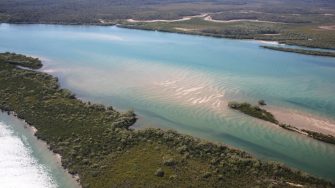
Date: Wednesday, October 5, 2016
Project: Eastern Australian Waterbird Survey
Observer - Richard Kingsford
One of my favourite days of survey – flying along the Queensland coastline, up to the Whitsunday Islands. First on our list were a few reservoirs west and north of Maroochydore. Not much to report on the wetlands around here, except for a couple of magpie geese and two great crested grebes. Then on to Lake Weyba with a few resting pelicans.
Estuarine lake south of Noosa
We are over the top of Noosa in no time and flying along the beach of the Great Sandy National Park, where wheel ruts intertwine along its entire length, creating stripes on the beach from the air, interrupted only by fishing camps and four wheel drive vehicles. It’s great to fly just on the seaward side of the waves where you can see the rays the size of vehicles in the shallows on one side of the plane and humpback whales breaching on the other side, only about hundred metres off shore.
Humpback cow and calf off the beach of the Great Sandy National Park
Hervey Bay next stop. This is one of Australia’s most magnificent estuaries. From a few hundred metres up in the air, hundreds of turtles look like miniature robots moving just below the surface of the shallow water. Muddy trails also lead to the long shadowy shapes of dugongs, grazing on the seagrass beds. The islands and shallow sandbeds form intricate patterns in the estuary, reflecting hues of blue.
Hervey Bay provides a magnificent array of habitats for turtles, dugongs and shorebirds
About an hour later, we reach the eastern side of Band 8, near Baffle Creek, north of Bundaberg. On Sunday and Monday, we will track west all the way along this survey band to lakes northwest of Birdsville, near the Northern Territory Border. This is one of the river environments which is changing reasonably rapidly, with the establishment of irrigation and fish farms. The new dams and impounded water habitats seldom have many waterbirds.
Surveying along one of the coastal creeks of the Baffle Creek system, north of Bundaberg
Surveying Baffle Creek
A quick lunch in Gladstone where one of the locals told us the flights are decreasing because the establishment phase for the port is over.
Curtis Island port for exporting liquefied natural gas, near Gladstone
Then north another 200km to the eastern part of Band 9, east of the Styx River. It is always hot here but always gives a kick because we often see the tropical waterbird species, such as Black-necked storks, Radjah shelducks and magpie geese. Here freshwater is backed up creating lagoons.
Lagoons often have thousands of waterbirds, east of the Styx River, north of Rockhampton
There was much more water here than we have seen for some time. Despite this, there werent many waterbirds once again, pointing to the amount of water around at the moment. We saw our first cotton pygmy geese and brolgas here.
Surveying the lagoons east of the Styx River with egrets and cotton pygmy geese
Similarly there was extensive flooding along the Styx River where I have seen magpie geese and black-necked storks as well as lots of brolgas. Not today but there were hundreds of swans and black ducks.
Surveying the Styx River, north of Rockhampton
Finally, we were at the top of the survey on Band 10 which stretches from the Whitsunday Islands, near Proserpine all the way to Mt Isa. Today, we just survey the floodplains of the Prosperine River. In recent surveys, the numbers of waterbirds has declined on these floodplain, probably due to the impact of Proserpine Dam regulating flood flows. Today is no different – just a few hundred egrets and magpie geese, not the thousands we used to see before Proserpine Dam was built.
Surveying the few patches of water on the Prosperpine River floodplain.
